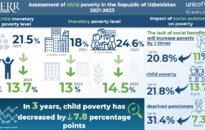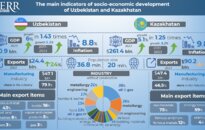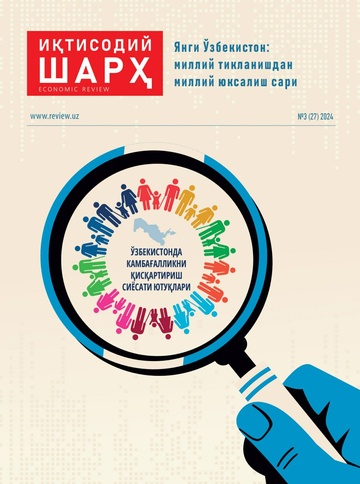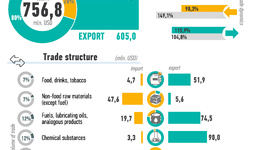In its quarterly study, the Center for Economic Research and Reforms assessed the Activity Index of 31 banks in the country.
Banks are divided into three groups:
• large banks with a government stake;
• competitive banks;
• centralized banks.
In order to regularly assess the share of the private sector in banking assets, as well as the effectiveness of reforms and transformation processes in the banking sector, the Center for Economic Research and Reforms has developed the Bank Activity Index, which consists of two sub-indices:
• Index of financial intermediation and availability;
• Index of financial stability of banks.
Currently, 32 commercial banks operate in the banking system of Uzbekistan. Of these, 13 banks have a state share in their authorized capital, 19 banks are private banks or banks with foreign capital. It should be noted that at the end of August, the Central Bank of Uzbekistan registered Anor Bank as the first digital bank.
The first sub-index of the Banking Activity Index was the Financial Intermediation and Availability Index. In determining this indicator, special attention was paid to the ratio of savings and time deposits in the real sector of the economy to the total amount of loans, the share of funds from other banks and financial institutions in total liabilities and the role of government funds in the formation of banks’ assets.
Financial intermediation
The ability of commercial banks to attract funds into the banking system and channel these funds to finance the most promising projects determines the activity of banks as financial intermediaries.
Therefore, when assessing the activities of banks in the field of financial intermediation, attention was paid to the ratio of savings and term deposits to the total volume of loans, the share of funds received from other banks and financial institutions in total liabilities, and the importance of financial resources from the state (Ministry of Finance and the Fund for Reconstruction and Development (FRRU)).
One of the indicators of financial intermediation is the ratio of deposits attracted from the real sector to loans. The higher this indicator, the more positive the Banking Activity Index and the less negative. As of 1 September 2020, the ratio of savings and term deposits to loans in the banking sector averaged 28% in 13 state-owned banks and 69% in banks with private and foreign capital. These numbers show the importance of funds other than savings and term deposits for large state-owned banks in lending.
In the 10 largest state-owned banks, the share of deposits and loans from other banks and financial institutions in total liabilities averages 58%. In banks with private and foreign capital, this figure reaches 22%. At the same time, the share of state funds in the structure of liabilities of large banks with a state share remains high. As of September 1, 2020, this figure was 19%.
Financial affordability
The financial availability of banks shows how affordable financial services are for small and medium-sized businesses and the level of attraction of the “bank-free” population to the banking sector. Taking these factors into account, the number of entrepreneurs who received a loan can be considered as one of the criteria for measuring the availability of banking services for each bank branch.
Ipak Yuli Bank, Agrobank and Hamkorbank have the highest indicators for this value. As of 1 September 2020, there were an average of 532 entrepreneurs per branch for each branch of Ipak Yuli Bank, while in Agrobank and Hamkorbank this figure was 476 and 411, respectively.
Another criterion for assessing financial affordability is the share of loans from the 10 largest clients in the total loan portfolio. In UzKDB Bank this figure was 78%, in Ravnak Bank - 57%, in Asaka Bank - 48%.
Banking activity index
Kapitalbank retained its 1st place in the rating of the Banking Activity Index in the 3rd quarter of 2020. This bank has shown good results in financial intermediation, taking 3rd place, in terms of financial availability in 4th place and profitability in 5th place.
In particular, the share of savings and term deposits in the total volume of loans increased to 87%, while the share of deposits and loans from other banks and financial institutions in total liabilities (3%) and the share of public funds in liabilities (1%) is much lower than on average across the banking system. The high financial inclusion index of Kapitalbank, in particular the low share of loans provided to the 10 largest clients, and the high ratio of loans to the private sector to the total volume of loans, put the bank in 4th place in this rating.
Universalbank took 2nd place in the overall rating. In particular, in the rating for financial intermediation, this bank took 4th place, 1st place for asset quality and 6th place for profitability. These indicators helped the bank move up 2 points in the overall rating. At the same time, the low results of Universalbank on capital adequacy show that the bank should pay special attention to the indicators of capital adequacy.
Among banks with a state share in the overall rating, Ipoteka Bank rose by 2 points, taking 15th place, Microcredit Bank - by 6 points (16th place) and Uzpromstroybank - by 4 points (19th place). These banks have seen positive developments in terms of financial intermediation and affordability.
At the same time, in comparison with the indicators of May, the rating of the Halyk Bank fell from 11th to 13th place. This is due to the fact that the bank’s indicators for asset quality and management efficiency were lower than the average for the banking system. In particular, the share of problem loans of this bank in the total loan portfolio amounted to 4%, the amount of profit per employee is 34.5 million soums (on average 64 million soums), the ratio of operating expenses to income is 53%.
Asaka Bank dropped 4 points and took 17th place in the overall ranking. This is due to the fact that the volume of deposits and loans received by the bank from other banks and financial institutions increased by 1.4 trillion soums. and obligations to the Ministry of Finance and the Fund for Reconstruction and Development of Uzbekistan - for 788 billion soums.





















leave a comment